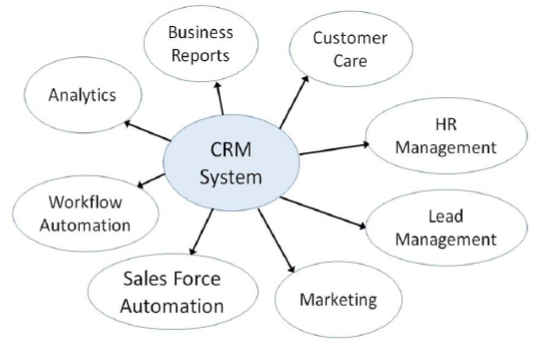What is CRM?
There can be multiple definitions of CRM from different perspectives −
- From the viewpoint of the Management, CRM can be defined as an organized approach of developing, managing, and maintaining a profitable relationship with customers.
- By equating the term with technology, the IT organizations define CRM as a software that assists marketing, merchandising, selling, and smooth service operations of a business.
- As per Franics Buttle, World’s first professor of CRM, it is the core business strategy that integrates internal processes and functions, and external networks, to create and deliver value to a target customer at profit. It is grounded on high quality customer data and information technology.
The primary goal of CRM is to increase customer loyalty and in turn improve business profitability.
Ingredients of CRM
Take a look at the following illustration. It shows the ingredients that work together to form a successful CRM system.

Here are some of the important ingredients of CRM −
- Analytics − Analytics is the process of studying, handling, and representing data in various graphical formats such as charts, tables, trends, etc., in order to observe market trends.
- Business Reporting − Business Reporting includes accurate reports of sales, customer care, and marketing.
- Customer Service − Customer Service involves collecting and sending the following customer-related information to the concerned department −
- Personal information such as name, address, age
- Previous purchase patterns.
- Requirements and preferences.
- Complaints and suggestions.
- Human Resource Management − Human Resource Management involves employing and placing the most eligible human resource at a required place in the business.
- Lead Management − Lead Management involves keeping a track of the sales leads and distribution, managing the campaigns, designing customized forms, finalizing the mailing lists, and studying the purchase patterns of the customers.
- Marketing − Marketing involves forming and implementing sales strategies by studying existing and potential customers in order to sell the product.
- Sales Force Automation − Sales Force Automation includes forecasting, recording sales, processing, and keeping a track of the potential interactions.
- Workflow Automation − Workflow Automation involves streamlining and scheduling various processes that run in parallel. It reduces costs and time, and prevents assigning the same task to multiple employees.
Objectives of CRM
The most prominent objectives of using the methods of Customer Relationship Management are as follows −
- Improve Customer Satisfaction − CRM helps in customer satisfaction as the satisfied customers remain loyal to the business and spread good word-of-mouth. This can be accomplished by fostering customer engagement via social networking sites, surveys, interactive blogs, and various mobile platforms.
- Expand the Customer Base − CRM not only manages the existing customers but also creates knowledge for prospective customers who are yet to convert. It helps creating and managing a huge customer base that fosters profits continuity, even for a seasonal business.
- Enhance Business Sales − CRM methods can be used to close more deals, increase sales, improve forecast accuracy, and suggestion selling. CRM helps to create new sales opportunities and thus helps in increasing business revenue.
- Improve Workforce Productivity − A CRM system can create organized manners of working for sales and sales management staff of a business. The sales staff can view customer’s contact information, follow up via email or social media, manage tasks, and track the salesperson’s performance. The salespersons can address the customer inquiries speedily and resolve their problems.


